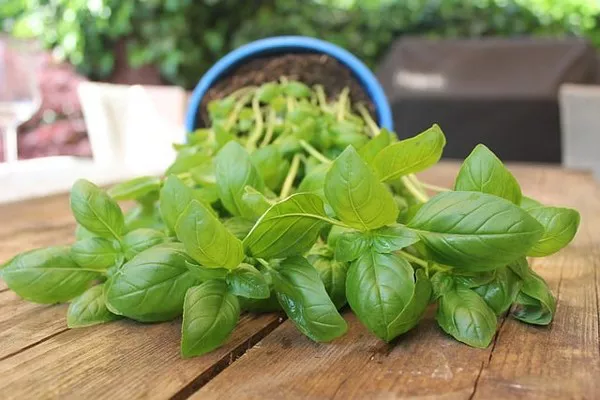Basil, with its vibrant aroma and versatile culinary uses, is a beloved herb in many kitchens and gardens worldwide. Whether you’re an avid gardener or a beginner with a green thumb, the question of how many basil plants to grow per pot is a common one. Maximizing growth while ensuring healthy plants requires careful consideration of factors such as pot size, variety of basil, and growing conditions. In this article, we’ll explore the optimal number of basil plants per pot to achieve thriving and bountiful harvests.
Understanding Basil Varieties and Growth Habits
Before diving into the specifics of pot sizes and plant numbers, it’s essential to understand the various types of basil and their growth habits. While there are numerous basil cultivars, some of the most popular varieties include Genovese basil, Thai basil, and Lemon basil. Each type has its unique flavor profile, fragrance, and growth characteristics.
Genovese basil, often referred to as sweet basil, is a classic variety with large, tender leaves and a sweet, slightly spicy flavor. Thai basil, on the other hand, boasts a distinct licorice flavor and purple-tinged stems, making it a staple in Southeast Asian cuisine. Lemon basil, as the name suggests, offers a refreshing citrus twist to dishes and emits a delightful lemony aroma.
In terms of growth habits, basil plants generally thrive in warm, sunny conditions with well-draining soil. They have a tendency to grow bushy and produce an abundance of leaves, especially when regularly pruned to encourage branching and new growth. Understanding the growth habits of the specific basil variety you’re cultivating is crucial for determining the appropriate spacing and pot size.
Factors Influencing Plant Density
Several factors influence the optimal number of basil plants to grow per pot, including pot size, growth habits, and intended use. Let’s delve into each of these factors in more detail:
1. Pot Size: The size of the pot plays a significant role in determining how many basil plants can comfortably thrive within it. Larger pots provide more room for root expansion and nutrient uptake, allowing for the cultivation of multiple plants. However, overly large pots can lead to waterlogging and stagnant soil conditions, which may negatively impact plant health. Choosing the right pot size is essential for balancing plant density with adequate growing space.
2. Growth Habits: Different basil varieties exhibit varying growth habits, including height, spread, and branching patterns. Some varieties, such as Genovese basil, tend to grow tall and bushy, while others, like Greek basil, have a more compact and trailing growth habit. Understanding the growth habits of your chosen basil variety will help you determine how many plants can comfortably coexist in a single pot without overcrowding.
3. Intended Use: Consider your intended use for the basil plants when determining plant density. If you primarily use basil for fresh culinary purposes, you may prefer to space the plants farther apart to allow for larger individual plants with abundant foliage. However, if you plan to harvest basil frequently for drying or preserving, denser planting may be more suitable to maximize yield within limited space.
Optimal Plant Spacing and Density
While there’s no one-size-fits-all answer to how many basil plants to grow per pot, certain guidelines can help you achieve optimal plant spacing and density. Here are some considerations to keep in mind:
1. Container Size: Choose a pot with a diameter of at least 8-12 inches for growing basil. Larger pots, such as 12-18 inches in diameter, can accommodate multiple basil plants comfortably. Ensure that the pot has drainage holes at the bottom to prevent waterlogging.
2. Spacing Between Plants: Aim to space basil plants approximately 6-8 inches apart within the pot to allow for adequate air circulation and prevent overcrowding. This spacing provides enough room for individual plants to grow and develop without competing excessively for resources.
3. Number of Plants: In a standard 12-inch diameter pot, you can typically grow 2-3 basil plants comfortably. For larger pots, such as 18 inches in diameter, you can increase the number of plants to 4-6, depending on the specific variety and growth habits. Avoid overcrowding the pot, as this can lead to stunted growth, increased susceptibility to diseases, and competition for nutrients.
4. Consider Companion Planting: Basil thrives when planted alongside compatible companion plants, such as tomatoes, peppers, and parsley. Companion planting not only maximizes space utilization but also promotes biodiversity and natural pest control in the garden. When selecting companion plants, ensure they have similar cultural requirements to basil, including sunlight and water needs.
5. Regular Maintenance: Proper maintenance practices, including watering, fertilizing, and pruning, are essential for maximizing the growth and productivity of basil plants. Water the plants consistently, keeping the soil evenly moist but not waterlogged. Fertilize with a balanced fertilizer every 2-3 weeks during the growing season to replenish nutrients in the soil. Additionally, pinch off the top leaves of the basil plants regularly to encourage branching and prevent flowering, which can diminish leaf production.
Conclusion
Determining the optimal number of basil plants per pot involves careful consideration of factors such as pot size, basil variety, and intended use. While there’s no one-size-fits-all answer, following general guidelines for plant spacing and density can help you achieve thriving and bountiful basil plants in containers. Remember to choose an appropriately sized pot, space the plants adequately, and provide regular maintenance to ensure optimal growth and productivity. By maximizing growth potential and optimizing space utilization, you can enjoy a plentiful harvest of fresh basil for culinary delights straight from your own garden.


